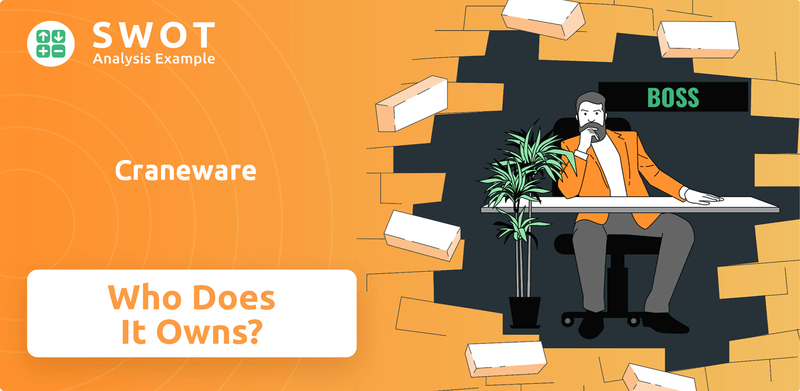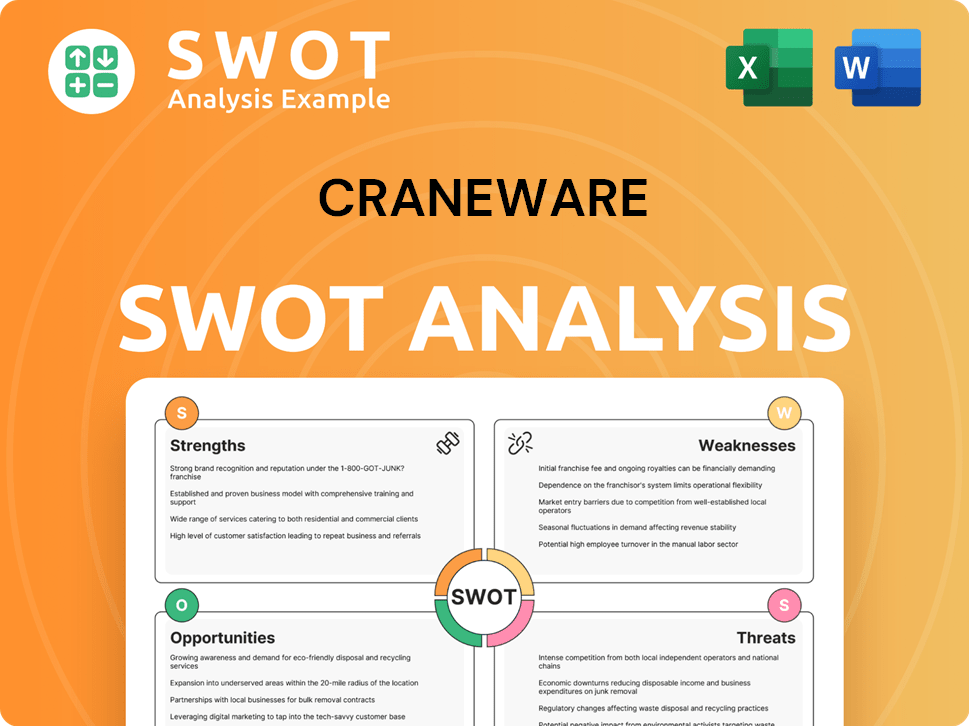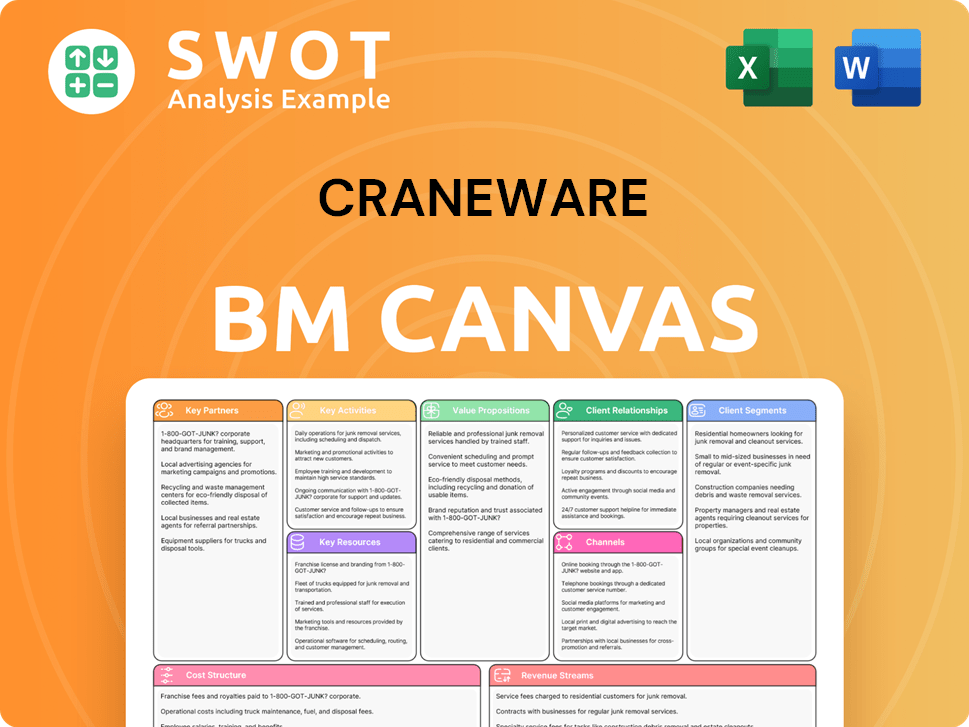Craneware Bundle
Who Really Controls Craneware?
Understanding the ownership structure of a company like Craneware is crucial for investors and stakeholders alike. Craneware, a key player in healthcare financial solutions, has a fascinating ownership journey. From its inception in 1999 to its current market position, the evolution of Craneware SWOT Analysis and its ownership tells a compelling story of growth and strategic shifts.

This exploration of Craneware ownership will uncover the key players shaping its destiny. We'll examine the influence of major shareholders, the impact of acquisitions like Sentry Data Systems and Agilum Healthcare, and the overall implications for Craneware's future. Discover who owns Craneware, and how these dynamics affect the company's strategic direction, including its financial performance and its position in the market. Learn more about Craneware's headquarters, executives, and the factors influencing its stock.
Who Founded Craneware?
The story of Craneware begins in May 1999, with Keith Neilson and Gordon Craig at the helm. Their initial aim was to create a specialized IT system, a 'charge master,' for US hospitals. This system was designed to streamline the management of patient billing and insurance claims, aiming to reduce errors and improve financial efficiency.
While the exact initial ownership breakdown isn't fully detailed in public records, Keith Neilson has consistently held a significant stake in the company. This demonstrates a strong commitment from the founder, which has been a key factor in the company's growth. The early backing from the Bank of Scotland and the Lothian Investment Fund helped to fuel the initial stages of Craneware's expansion.
Craneware's early success is evident in its rapid customer acquisition. By the end of 2000, the company already had over 20 customers. This early growth set the stage for Craneware's future success. The consistent leadership and substantial shareholding of Keith Neilson, with only a 13% reduction in his stake since the flotation, highlight a founder-led approach that has historically benefited investors.
Keith Neilson, CEO and co-founder, and Gordon Craig co-founded the company.
The primary goal was to develop a 'charge master' IT system for US hospitals.
Funding was secured from the Bank of Scotland and the Lothian Investment Fund.
Craneware had over 20 customers by the end of 2000.
Keith Neilson has maintained a substantial ownership stake.
Keith Neilson directly owns 9.07% of the shares, valued at approximately £65.42 million.
Understanding the ownership structure of a company like Craneware is crucial for investors. The founders' continued involvement and significant shareholdings often indicate a strong commitment to the company's long-term success. For those interested in the competitive landscape, further details can be found in the Competitors Landscape of Craneware.
- Keith Neilson, as CEO, holds a significant portion of Craneware's stock.
- Gordon Craig, a co-founder, also has a notable stake in the company.
- Early investors included the Bank of Scotland and the Lothian Investment Fund.
- The company's consistent growth and founder-led leadership have historically benefited investors.
Craneware SWOT Analysis
- Complete SWOT Breakdown
- Fully Customizable
- Editable in Excel & Word
- Professional Formatting
- Investor-Ready Format

How Has Craneware’s Ownership Changed Over Time?
The journey of the Craneware company, a publicly traded entity, began with its listing on the AIM market of the London Stock Exchange in September 2007. This marked a significant milestone, setting the stage for its evolution. A notable shift in Craneware ownership occurred in July 2021 with the acquisitions of Sentry Data Systems and Agilum Healthcare. These strategic moves involved the issuance of new ordinary shares, reshaping the company's shareholder structure.
As of June 13, 2025, the company's market capitalization stands at approximately $955 million, with a total of 35.4 million shares outstanding. This provides a snapshot of its current valuation and the distribution of ownership among its shareholders. The evolution of Craneware ownership reflects its growth and strategic acquisitions over time.
| Date | Event | Impact on Ownership |
|---|---|---|
| September 2007 | Initial Public Offering (IPO) | Listing on AIM market, London Stock Exchange |
| July 2021 | Acquisition of Sentry Data Systems and Agilum Healthcare | Issuance of 2,507,348 new ordinary shares |
| February 17, 2025 | Aegon Ltd. increased its total voting rights | Aegon Ltd. increased its total voting rights in Craneware plc to 5.168% |
| June 2, 2025 | BlackRock Fund Advisors shareholding | BlackRock Fund Advisors held 1.65% of shares (584,830 shares) |
| May 29, 2025 | Deka Investment GmbH shareholding | Deka Investment GmbH held 1.59% (561,830 shares) |
The major shareholders of the Craneware company include institutional investors. Liontrust Investment Partners LLP held 11.947% of voting rights as of December 11, 2023, which is equivalent to 4,223,433 shares. Other significant holders include Liontrust Special Situations Fund, Aegon Scottish Equitable, and Liontrust UK Smaller Companies Fund. Founder Keith Neilson holds 9.07% of the company's shares. The Target Market of Craneware is also important to understand to know more about the company.
The Craneware ownership structure is primarily shaped by institutional investors and the founder. The company's financial performance, with revenue increasing to $189.3 million for the year ended June 30, 2024, and Annual Recurring Revenue (ARR) reaching $177.3 million as of December 31, 2024, has likely influenced investor interest.
- Institutional investors hold a significant portion of the shares.
- The founder, Keith Neilson, retains a substantial ownership stake.
- Strategic acquisitions have impacted the share structure.
- The company's financial health is a key factor for investors.
Craneware PESTLE Analysis
- Covers All 6 PESTLE Categories
- No Research Needed – Save Hours of Work
- Built by Experts, Trusted by Consultants
- Instant Download, Ready to Use
- 100% Editable, Fully Customizable

Who Sits on Craneware’s Board?
The current board of directors of the Craneware company includes Will Whitehorn as Chairman, alongside three executive directors: Keith Neilson (Chief Executive Officer), Craig Preston (Chief Financial Officer and Company Secretary), and Issy Urquhart (Chief People Officer). The board also comprises five independent non-executive directors: Alistair Erskine, David Kemp, Anne McCune, Tamra Minnier, and Susan Nelson. Tamra Minnier and Susan Nelson were appointed as Non-Executive Directors in November 2024 and January 2025, respectively, bringing extensive experience in the US healthcare market. This structure reflects a commitment to diverse expertise and independent oversight, crucial for strategic decision-making and corporate governance.
The composition of the board and its committees is subject to ongoing review. For example, Anne McCune replaced Colleen Blye on the Audit and Remuneration Committees, effective November 16, 2023, following Colleen Blye's decision not to stand for re-election in November 2024. The company's adherence to The UK Corporate Governance Code (July 2018 version) ensures that all directors retire at the AGM and submit themselves for re-election, promoting accountability and responsiveness to shareholder interests. This structure supports the company's commitment to maintaining a robust governance framework.
| Director | Role | Appointment Date |
|---|---|---|
| Will Whitehorn | Chairman | N/A |
| Keith Neilson | CEO | N/A |
| Craig Preston | CFO & Company Secretary | N/A |
| Issy Urquhart | Chief People Officer | N/A |
| Alistair Erskine | Non-Executive Director | N/A |
| David Kemp | Non-Executive Director | N/A |
| Anne McCune | Non-Executive Director | N/A |
| Tamra Minnier | Non-Executive Director | November 2024 |
| Susan Nelson | Non-Executive Director | January 2025 |
Keith Neilson, as co-founder and CEO, directly owns 9.07% of the company's shares. The company operates on a one-share-one-vote basis, typical for companies listed on the AIM market. There have been no recent reports of dual-class shares or special voting rights. Although there have been no recent proxy battles or activist investor campaigns, the board actively reviews succession plans and the composition of its committees. For more insights into the company's business model, consider reading about Revenue Streams & Business Model of Craneware.
Understanding Craneware ownership involves examining the board of directors and the voting power structure.
- The board includes executive and independent non-executive directors.
- The CEO, Keith Neilson, holds a significant share of the company's stock.
- The company follows a one-share-one-vote principle.
- Governance aligns with the UK Corporate Governance Code.
Craneware Business Model Canvas
- Complete 9-Block Business Model Canvas
- Effortlessly Communicate Your Business Strategy
- Investor-Ready BMC Format
- 100% Editable and Customizable
- Clear and Structured Layout

What Recent Changes Have Shaped Craneware’s Ownership Landscape?
Over the past three to five years, significant developments have reshaped the ownership landscape of the company. A share buyback program, allocated £5 million ($6.3 million), concluded in May 2024 after multiple extensions, with the final one announced in April 2024 to run until July 17, 2024. As of October 16, 2024, the company held 199,453 ordinary shares in treasury from this program. These moves reflect the company's strategy regarding its Craneware ownership structure.
Institutional ownership has seen subtle shifts, as observed in recent filings. Danske Bank (1.53%), Aberdeen (3.45%), and Canaccord Genuity (4.84%) have increased their stakes, potentially indicating strategic intentions. Aegon Ltd. also boosted its stake to 5.168% by February 2025. Although Liontrust Investment Partners LLP remains a significant holder, their voting rights decreased slightly from 12.837% to 11.947% by December 2023. These changes are crucial for understanding who owns Craneware and how the company is perceived in the investment community. The company's performance, including record interim group revenue of $100.0 million and adjusted EBITDA of $30.3 million for the six months ended December 31, 2024, continues to underpin its market position and potential for future growth.
| Ownership Trends | Details | Date |
|---|---|---|
| Share Buyback Program | £5 million ($6.3 million) allocated | Concluded May 2024, Extended to July 17, 2024 |
| Danske Bank | Increased stake to 1.53% | May 2025 |
| Aberdeen | Increased stake to 3.45% | May 2025 |
| Canaccord Genuity | Increased stake to 4.84% | May 2025 |
| Aegon Ltd. | Increased stake to 5.168% | February 2025 |
| Liontrust Investment Partners LLP | Decreased voting rights from 12.837% to 11.947% | December 2023 |
Leadership changes, including the appointments of Tamra Minnier in November 2024 and Susan Nelson in January 2025 as Non-Executive Directors, also impact the company's direction. Moreover, an alliance with Microsoft is expected to boost innovation, which may affect Craneware stock performance. The company's strong financial health, driven by high recurring revenue and solid cash generation, provides a robust base for its growth strategy, making it essential for stakeholders to monitor these developments closely. For more insights, you can explore additional information on the company's profile.
The CEO of Craneware is Keith Neilson.
Yes, Craneware is a publicly traded company.
The company's headquarters are in Edinburgh, Scotland.
Record interim group revenue of $100.0 million and adjusted EBITDA of $30.3 million for the six months ended December 31, 2024.
Craneware Porter's Five Forces Analysis
- Covers All 5 Competitive Forces in Detail
- Structured for Consultants, Students, and Founders
- 100% Editable in Microsoft Word & Excel
- Instant Digital Download – Use Immediately
- Compatible with Mac & PC – Fully Unlocked

Related Blogs
- What are Mission Vision & Core Values of Craneware Company?
- What is Competitive Landscape of Craneware Company?
- What is Growth Strategy and Future Prospects of Craneware Company?
- How Does Craneware Company Work?
- What is Sales and Marketing Strategy of Craneware Company?
- What is Brief History of Craneware Company?
- What is Customer Demographics and Target Market of Craneware Company?
Disclaimer
All information, articles, and product details provided on this website are for general informational and educational purposes only. We do not claim any ownership over, nor do we intend to infringe upon, any trademarks, copyrights, logos, brand names, or other intellectual property mentioned or depicted on this site. Such intellectual property remains the property of its respective owners, and any references here are made solely for identification or informational purposes, without implying any affiliation, endorsement, or partnership.
We make no representations or warranties, express or implied, regarding the accuracy, completeness, or suitability of any content or products presented. Nothing on this website should be construed as legal, tax, investment, financial, medical, or other professional advice. In addition, no part of this site—including articles or product references—constitutes a solicitation, recommendation, endorsement, advertisement, or offer to buy or sell any securities, franchises, or other financial instruments, particularly in jurisdictions where such activity would be unlawful.
All content is of a general nature and may not address the specific circumstances of any individual or entity. It is not a substitute for professional advice or services. Any actions you take based on the information provided here are strictly at your own risk. You accept full responsibility for any decisions or outcomes arising from your use of this website and agree to release us from any liability in connection with your use of, or reliance upon, the content or products found herein.